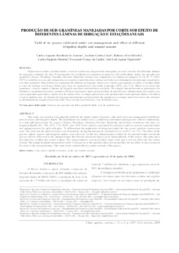Produção de seis gramíneas manejadas por corte sob efeito de diferentes lâminas de irrigação e estações anuais.
Produção de seis gramíneas manejadas por corte sob efeito de diferentes lâminas de irrigação e estações anuais.
Author(s): ALENCAR, C. A. B. de; CÓSER, A. C.; OLIVEIRA, R. A. de; MARTINS, C. E.; CUNHA, F. F. da; FIGUEIREDO, J. L. A.
Summary: RESUMO - Objetivou-se avaliar a produtividade e o teor de matéria seca de gramíneas manejadas por corte sob efeito de diferentes lâminasdeirrigaçãoeestaçõesdoano.Oexperimentofoiconduzidoemesquemadeparcelassub-subdivididas,tendonasparcelasseisgramíneas (Xaraés, Mombaça, Tanzânia, Pioneiro, Marandu e Estrela), nas subparcelas seis lâminas de irrigação (0, 18, 45, 77, 100 e120% da referência) e nas sub-subparcelas as estações (outono/inverno e primavera/verão) no delineamento inteiramente casualizado,com duas repetições. Para diferenciar a aplicação das lâminas de irrigação, utilizou-se o sistema por aspersão em linha. A produtividadeeoteordematériasecaforamobtidospormeiodomaterialsecoemestufaventiladaa60°C,por72h.Observou-seefeitodasgramíneas, estações anuais e lâminas de irrigação nas duas características avaliadas. Na estação outono/inverno as gramíneas nãodiferiram e na primavera/verão a gramínea Pioneiro apresentou maior produtividade de matéria seca. Independente da estação, essamesma gramínea apresentou o menor teor de matéria seca. A estação primavera/verão proporcionou maior produtividade e não afetouo teor de matéria seca. As lâminas de irrigação aumentaram a produtividade das gramíneas na estação outono/inverno e não afetaramou diminuíram na estação primavera/verão. Esse mesmo fator reduziu o teor de matéria seca. ABSTRACT - This study was aimed at evaluating the yield and dry matter content of grasses cultivated under cut management and differentannual seasons and irrigation depths. The experiment was carried out in a completely randomized arrangement, with two replications,inasplit-splitplotdesign.Sixgrasses(Xaraes,Mombaça,Tanzania,Pioneiro,Marandu,andEstrela)constitutedtheplots,sixirrigation depths (0%, 18%, 45%, 77%, 100%, and 120% of the control) constituted the split-plots and two seasons (autumn/winterandspring/summer)thesplit-split-plots.Todifferentiatetheapplicationofirrigationdepthsthelinesourcesprinklersystemwasused. The yield and dry matter content were obtained by drying the material in ventilated stoves at 60°C, for 72 h. The effect of thegrasses,annualseasonsandirrigationdepthswereobservedforthetwocharacteristicsstudied.Intheautumn/winterseasonthegrassesdidnotdifferandinthespring/summerthePioneiropresentedlargeryield.Independentlyoftheseason,thissamegrasspresentedthesmallestdrymattercontent.The spring/summer season provided larger yield anditdid notaf fectthedry mattercontent. The irrigation depths increased the yield of the grasses in the autumn/winter season and they did not affect or they decreasedthe yield in the spring/summer. This same factor reduced the dry matter content of the grasses.
Publication year: 2009
Types of publication: Journal article
Unit: Embrapa Dairy Cattle
Keywords: Gramínea, Irrigação por Aspersão, Matéria Seca, Produtividade
Observation
Some of Embrapa's publications are published as ePub files. To read them, use or download one of the following free software options to your computer or mobile device. Android: Google Play Books; IOS: iBooks; Windows and Linux: Calibre.
Access other publications
Access the Agricultural Research Database (BDPA) to consult Embrapa's full library collection and records.
Visit Embrapa Bookstore to purchase books and other publications sold by Embrapa.

